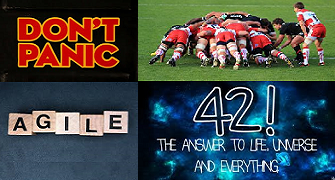The Hitchhiker’s Guide to Killing Agile (7/?)

Sadly, […] a terribly stupid catastrophe occurred. […] it is the story of that terrible stupid catastrophe and some of its consequences.
It is also the story of a book, a book called The Hitchhiker’s Guide to Killing Agile, not an Agile book, never published on Agile website, and until the terrible catastrophe occurred, never seen or heard of by any Agile team members.
Nevertheless, a wholly remarkable book. […]
It begins with a polysemic word…
In this new leg of our journey to try to survive The Hitchhiker’s Guide to Killing Agile, I guess I can assume you are familiar with the well-known Scrum motto “inspect and adapt”.
The thing is —I don’t know if it’s just my feeling or a more general concern—, recently I have been noticing a new worrying trend in the interpretation of the second part of this slogan, as though what the polysemic verb adapt means here was not really clear to everybody.
Let’s see. According to the Merriam Webster, for instance, there are two main meanings for this verb.
The first one: ‘to change your behavior so that it is easier to live in a particular place or situation’.
The second one: ‘to change (something) so that it functions better or is better suited for a purpose’.
I’m pretty sure that, when Jeff Sutherland and Ken Schwaber wrote the Scrum Guide, they were thinking about the second meaning, especially when referring to the daily meeting: if something is not doing as well as expected, adapt (whatever is needed) to better align with the sprint goal.
It never came to my mind that someone could interpret this verb in a different way in this context.
However, it looks like nowadays the first meaning is more and more often suggested by some alleged Scrum implementers: as some organizations cannot be easily changed and as some impediments are difficult to be removed, just adapt yourself and the Scrum principles to the environment; in other words, act like a chameleon.
I don’t know if this trend is just an involuntary misunderstanding or rather a deliberate misinterpretation, but I’m quite sure that neither opportunism nor a live-with-it mindset are among the Scrum values.
So, talking by means of animal analogies, I think Scrum is not about in-disguise chameleons or any other almost invisible creatures: it’s rather about smart and forward-looking lynxes, always able to see the big picture and to rapidly react to whatever situation.
In other words, while working within a Scrum framework, if you persist in acting like a chameleon, you’ll eventually end up like the elephant in the room that nobody wants to see.

Thanks for reading this article.
Feel free to recommend it or to add a comment.
Should you have any doubts about Agile, please contact me: I will be glad to help you.
On the other hand, if you want to get notified about my blog posts, please sign up through the BLOG > SUBSCRIBE TO THE BLOG NEWSLETTER menu.
Thank you.